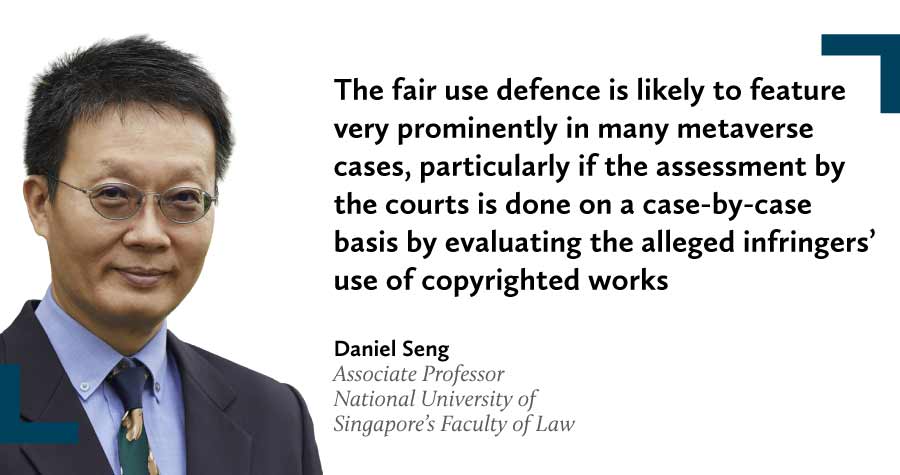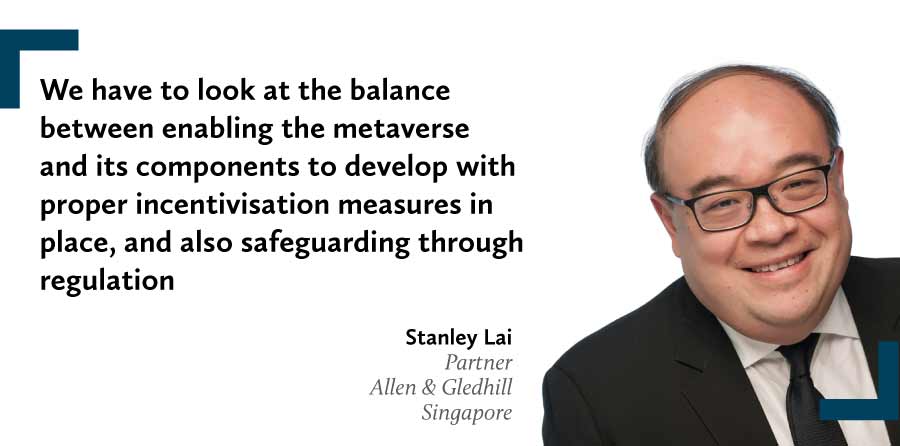Current and potential applications of the metaverse are endless, but the new digital realm has raised novel issues that have confronted legal professionals in various roles. Putro Harnowo recaptures the views of tech experts attending a recent industry event
T
he metaverse has taken the spotlight as a limitless world that may be navigated and explored as virtual reality. This augmented world occurs through vision in the form of a head-mounted display, operating alongside audio or haptic sensory feedback that is elicited from devices that are worn by the user. Singapore’s TechLaw.Fest 2022 sought to answer questions arising in the new space by bringing together well-known experts to offer possible solutions to the challenges posed.
“We have to look at the balance between enabling the metaverse and its components to develop with proper incentivisation measures in place, and also safeguarding through regulation,” says Stanley Lai, partner and head of IP practice at Singapore law firm Allen & Gledhill. “Success and harm arise from abuse and exploitation. A balance can only be achieved by the convergence of non-legal rights, technologies, as well as the possibility of new evolving rights and obligations.”
In IP matters, issues of copyright, trademarks and personality rights have become enigmas that are convoluted with decentralised technologies. Unregulated content has also posed harm to its users, in addition to the difficulties with enforcement beyond the platform space. For those seeking and currently involved in the metaverse project, the contractual interface, liability risk mitigation and data privacy laws are among the first to ponder.
“Being an IP and commercial litigation lawyer for more than 25 years, I’ve seen our professional roles incrementally evolving,” says Lai. “Lawyers who practise in this field now have to be the embodiment of expertise and IP content regulation, data protection and the law of obligations.”
 IP rights analysis
IP rights analysis
Earlier this year, Hermes sued digital artist Mason Rothschild for selling collections of NFTs called MetaBirkins, which were intended to be a playful abstraction of an existing fashion culture landmark, the famous Hermes Birkin, in the metaverse. The limited edition NFTs were sold for USD450 each late last year, collecting USD46,000 in just two weeks.
The French luxury brand stated that MetaBirkins infringed on Hermes’ trademark rights and were an example of fake products in the metaverse, while demanding Rothschild and the companies that made available the MetaBirkins for sale remove the NFTs. Although Rothschild is currently contesting the cease-and-desist order, the largest NFT marketplace, Opensea, has complied and removed MetaBirkins from its platform.
In AM General v Activision Blizzard, where Activision Blizzard reproduced military vehicle Humvees in their gaming platform, Call of Duty, the reproduction of Humvees is so realistic that the game company was sued by the vehicle manufacturer, AM General. However, the courts gave Activision a credit for their work, as the game maker had no choice but to make an accurate reproduction of the vehicles to make the war zone environment realistic.
“We can start this analysis by walking ourselves through the various scenarios in trademark law to see how this will actually play out before the courts,” says Daniel Seng, associate professor at the National University of Singapore’s Faculty of Law. “The fundamental rule in trademark law is that a mark is to be used in relation to goods and services, so if a mark is not associated with or used in relation to goods and services, it falls outside of the trademark regime, and trademark law will not govern the issues in that particular instance.”
Copyright law is also exemplified by the fact that it centres around the rights of reproduction, Seng adds, including the conversion from two or three dimensions and vice-versa. A good example of this is United Feature Syndicate v Koons (1993), where American artist Jeff Koons created a sculpture named Wild Boy and Puppy.
Koons argued that the puppy was an accidental reproduction of Odie, the dog from the Garfield comics, and contended that this was fair use. However, the courts were not convinced, as Koons had made multiple copies of his sculpture for sale, which was therefore detrimental to his fair use defence.
“The fair use defence is likely to feature very prominently in many metaverse cases, particularly if the assessment by the courts is done on a case-by-case basis by evaluating the alleged infringers’ use of copyrighted works,” says Seng. “Even though the fact that a work could have commercial use is not a factor that would preclude the application of the fair use test, the fact that the use of a work can have potential commercial ramifications in relation to the market of the original work will negatively affect the user’s reliance on the fair use test.”

“The interesting thing about this particular right is that, at least in common law jurisdictions outside of the US, it overlaps with the right to privacy and the right to be left alone and data protection rights,” says Seng. “One needs a holistic analysis of IP rights when analysing personality rights because one must also consider the data protection issues associated with subjects like these.”
From a wider perspective, Seng expects legislators to evaluate the need to further harmonise copyright rules in the metaverse. For example, the internet era has sparked the World Intellectual Property Organisation (WIPO) to ratify and update its internet treaties that lay down an international framework for protecting unauthorised access to and use of creative works on the internet and other digital networks.
You must be a
subscribersubscribersubscribersubscriber
to read this content, please
subscribesubscribesubscribesubscribe
today.
For group subscribers, please click here to access.
Interested in group subscription? Please contact us.



























